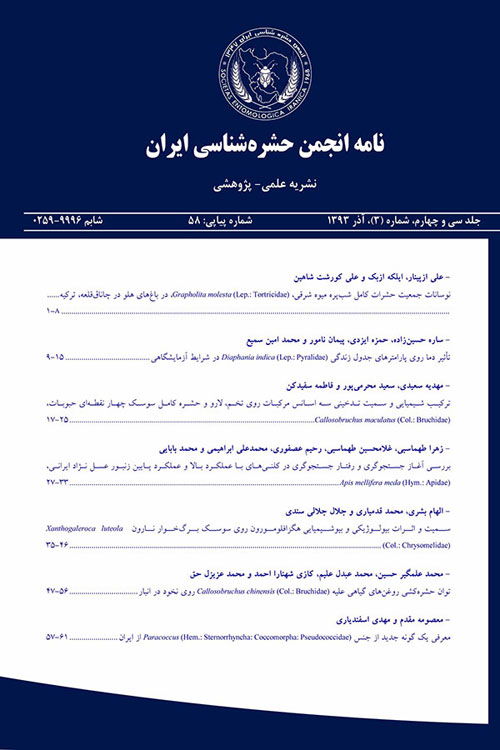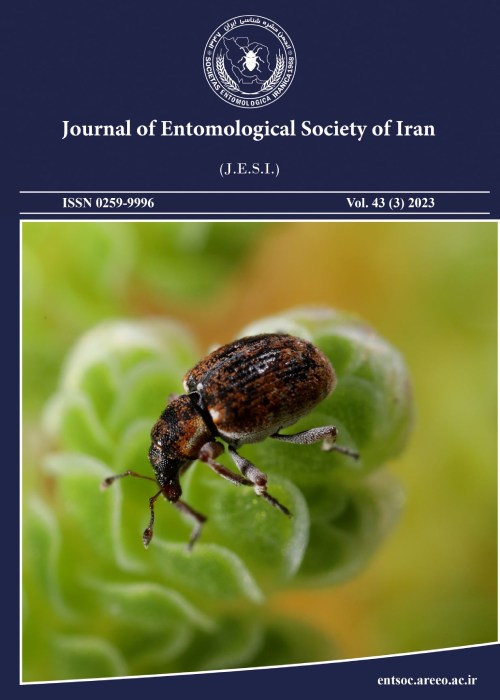فهرست مطالب

نشریه نامه انجمن حشره شناسی ایران
سال سی و ششم شماره 2 (پیاپی 65، تابستان 1395)
- تاریخ انتشار: 1395/07/07
- تعداد عناوین: 8
-
-
Pages 81-88The effect of a neuropeptide, the tachykinin on α-amylase, protease and lipase activities in the midgut of American cockroach, Periplaneta americana (Linnaeus) is evaluated . Immunohistochemical reactivities against tachykinin (tachykinin- ir) were detected in the midgut. Tachykinin-ir cells in three regions (anterior, median and posterior) of the midgut were counted in normally fed, starved for four weeks and refed cockroaches. The number of tachykinin-ir cells decreased during 4 weeks of starvation and increased 3 h after refeeding. The results of the competitive ELISA were consistent with the profile of immunohistochemical reactivity. Incubation of the dissected midgut with tachykinin led to an increase in α-amylase, protease and lipase activities while the buffer remained ineffective. Tachykinin injection into the hemocoel increased α-amylase, protease and lipase activities, but PBS injection showed no sign of effectiveness. The results seggest that nutrients upregulate midgut cells secreting tachykinin causing further activities of digestive enzymes.Keywords: Tachykinin, Digestive enzymes, Midgut, Periplaneta americana
-
Pages 89-97A survey was conducted to determine the species of the genus Lissonota Gravenhorst, 1829 in two Iranian southern provinces of Fars and Hormozgan from February 2011 through August 2013. Six species were identified of which five species are recorded for the first time from Iran. The newly recorded species are as follows: Lissonota bivittata Gravenhorst, 1829, L. clypeator Gravenhorst, 1820, L. impressor Gravenhorst, 1829,
L. pimplator (Zetterstedt, 1838) and L. proxima Fonscolombe, 1854. An updated checklist of Iranian Lissonota species is presented.Keywords: Lissonota, taxonomy, Fars, Hormozgan, Iran -
Pages 99-109The influence of parasitoids on population dynamics is affected by host instar preference. The preference pattern of host instars is not fixed and is modified by the availability and relative abundance of host instars, intensity of defensive behaviors in a particular instar, and also maternal effects of the female forager. In this study, host instar preference of the thelytokous strain of Lysiphlebus fabarum (Marshall) was studied in relation to progeny performance in choice and no-choice experiments, using the first, second, and fourth host instars of Aphis fabae (Hemiptera: Aphididae) as hosts. In addition, we investigated whether the maternal effects (age and size) influenced preference-performance associations. Based on the results, offsprings emerging from hosts that were parasitized as the first instar stage were smaller and took longer to develop than offsprings emerging from hosts that were parasitized as the second and fourth instars, irrespective of the age and size of their mothers. The results also showed that when females were offered different host instars under no-choice access, there was no preference for a specific instar, irrespective of the size and age of the female. However, in a choice situation, for the both age and size classes of the parasitoid mother, the number of mummies declined with increasing host instar, suggesting that host instar preference does not reflect offspring performance. For mass rearing of L. fabarum, it would be better if female foragers be introduced to lower density of first instar, under choice situation because of increasing offspring performance.Keywords: Aphididae, Hemiptera, Fitness, Maternal effect, progeny performance
-
Pages 111-119Soil-dwelling nematodes from Steinernematidae family are obligate parasites of insects and usually referred to as entomopathogenic nematodes (EPNs). These nematodes are symbiotically associated with entomopathogenic bacteria Xenorhabdus spp. The bacterial symbionts are carried monoxenically in a special vesicle in the infective juveniles (IJs). In the present study we report the isolation of two species of non-symbiotic bacteria from infected insect cadavers by the EPN, Steinernema feltiae. Galleria mellonella L. larvae were exposed to surface sterilized infective juveniles of S. feltiae and transferred to sterile Petri dishes for a further 24 hours. Hemolymph was collected and streaked onto both MacConkey and NBTA agar. Bacteria were identified using biochemical and phylogenetic analysis. 16S-rRNA gene sequence based maximum parsimony, maximum likelihood and neighbour joining phylogenetic analyses were conducted. Two non-symbiotic species including Citrobacter freundii and Staphylococcus succinus were identified and reported to be associated with S. feltiae. Our results provide further evidence for the existence of non-symbiotic bacteria associated with EPNs infection.Keywords: Entomopathogenic nematode, Steinernema feltiae, Citrobacter freundii, Staphylococcus succinus
-
Pages 121-136The present faunal study of springtails (Collembola) was conducted -in city of Tehran during 2013-2014. Samples of soil and leaf litters from parks, forests, gardens and green landscapes were collected using Berlese funnels. A total of 21 species of eight families were identified of which the species Hypogastrura ripperi (Gisin, 1952), Mesaphorura macrochaeta (Rusek, 1976) and Friesea claviseta (Axelson,1900) are newly recorded from Iran and six species are recorded from Tehran for the first time. This study rises the number of known collembolan species from Tehran to 71 species.Keywords: Collembola, Entomobryomorpha, Poduromorpha, Tehran province, Iran
-
Pages 137-146Entomopathogenic fungi may be affected by pesticides used to protect crop plants. The in vitro compatibility of Beauveria bassiana and Metarhizium anisopliae with three fungicides and 16 insecticides was evaluated. The formulations of pesticides were tested in three concentrations (mean concentration (MC), half MC and twice the MC). All tested fungicides, at three concentrations, were incompatible with these two fungi and significantly inhibited fungal development, germination of spores and spore production. Insecticides, except for spinosad, deltametrin, imidachloprid and abamectin, were incompatible with these two fungi at high concentration and caused complete or strong inhibition of fungal development. The compatible insecticide with B. bassiana and M. anisopliae, at three concentrations, found to be spinosad. Abamectin, imidachloprid and deltametrin, however at half MC and MC were compatible with B. bassiana. Deltametrin, abamectin and hexafloron at half MC were compatible with M. anisopliae. We conclude that these pesticides with the defined formulations could be used with the entomopathogenic fungi in integrated pest management programs.Keywords: Beauveria, Metarhizium, compatibility, pesticide, entomopathogenic fungus


